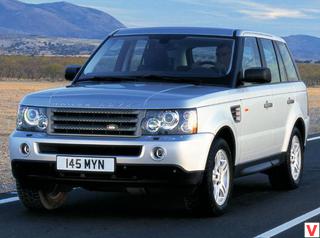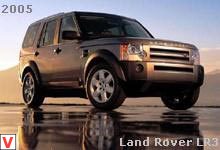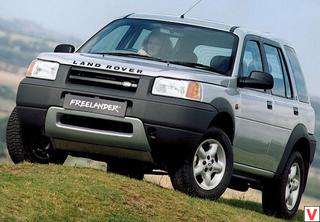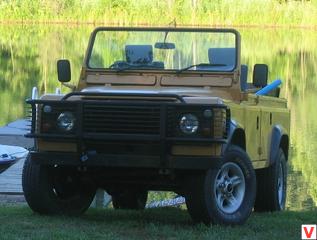
Today's Range Rover is already a legendary SUV. The car, which owes its fame to the British brand. Work on the first prototype of the Range Rover, known as the “100-inch station wagon,” began in 1966. The debut of the production version took place in 1970. The car was even exhibited in the Louvre as an outstanding example of modern industrial design. After this, the Range Rover was decided to make a symbol of luxury and prestige. Therefore, since 1973, leather upholstery began to enter the standard equipment, and since 1979, and air conditioning.
Initially, the model was produced in a three-door version, but in 1981 the first four-door Range Rover, as well as the first factory model of a limited edition Range Rover In Vogue, saw the light. A year later, in 1982, began to install an automatic transmission. All these improvements were necessary for success in the US market, where sales began in 1987. The first generation, now called the Classic, has been on the conveyor for more than 25 years. Range Rover was the first all-wheel drive luxury car. In 1994, the second generation appeared, known as the P38a.
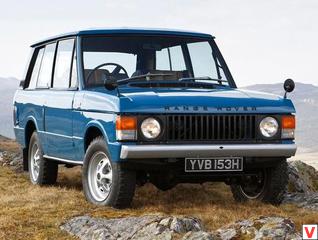
It is noteworthy that in the period from 1994 to 1996 produced both generations of the Range Rover. The second-generation car has become larger: increased length and width of the model. The updated stylish appearance was supplemented with a wide list of technical equipment. In the interior trim, high-quality and expensive materials are used: high-quality leather, natural wood inserts, soft plastic. It has everything you need: climate control with separate adjustment for the right and left side of the cabin, cruise control, an onboard computer, a high-end audio complex with a CD changer, four airbags and so on.
Individual words deserve cars in the performance of Vogue, Autobiography or Anniversary (was released in an edition of 500 copies in honor of the 30th anniversary of the production model). These cars have a more elegant trim, the use of multi-color leather in the interior trim, the original wheels and body, painted manually in several layers. Land Rover Range Rover II was offered to choose from one of several power units: 6-cylinder, diesel, 2.5-liter (developed by BMW) and V-shaped, 8-cylinder, 4.0-liter or 4.6 l.
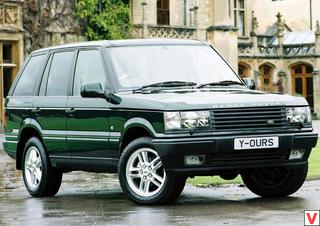
The 4.6 liter engine allowed us to reach a speed of 201 km / h and accelerate the car to 96.5 km / h in 9.3 s, which was the fastest result for the production Range Rover cars at that time. The height-adjustable suspension, which debuted at the end of the Classic’s life, was enhanced for the second-generation model and was offered as a standard option for increased driving comfort and off-road performance. The second generation of the Range Rover lasted only 7 years. In late 2001, a completely new version of the SUV with a monocoque body appeared, which received the factory designation L322. Range Rover III was a big step forward.
He set new benchmarks in the segment of all-wheel drive cars, both in terms of luxury and in terms of opportunities for road and off-road driving. The creators deliberately retained the silhouette and the main features of the progenitor: chopped “nose”, thick rear pillars with a characteristic angle of inclination, horizontally divided tailgate and hood. At the same time in the Range Rover III there is something futuristic, for example, the side metallized "gills" of the engine compartment. Range Rover III has grown in length and height.
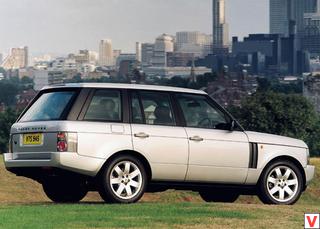
Despite the widespread use of aluminum (hood, front fenders and full doors), the car's weight increased by 220 kg, making it one of the heaviest mass-produced cars. Growth in size has affected, a lot of metal has gone to protect passengers (the effectiveness of the measures taken has been brilliantly confirmed in the EuroNCAP crash test series), and an abundance of additional equipment brought its share. Among the new features were a more rigid frameless body (which replaced the traditional ladder-type frame for SUVs) and a fully independent suspension with interconnected air springs.
Air suspension allows you to change the clearance. Normal and automatically set with increasing speed, the reduced position corresponds to riding on a hard surface, the top one is designed to move in a serious rut, and for the convenience of getting into the car with one movement of the toggle switch, you can make it sit down. The car quickly recognizes the fact of departure from asphalt and connects the pneumatic elements of the right and left wheels of each axle, thus simulating the operation of a dependent suspension with continuous bridges.
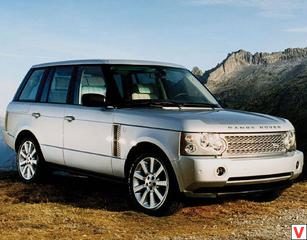
Torque between the axles is split in half through the Torsen self-locking differential, which is able to transfer up to two thirds of the torque to the axle wheels with the best grip. There are no other locks, but they are successfully replaced by the stabilization system, which slows down the driveway on off-road vehicles. It also implements the proprietary function of assistance when descending the slippery hills of Hill Descent Control. By the way, the system is not turned off, and the key provided for its deactivation on the console only blocks the intervention of electronics trying to “strangle” the engine when the wheels slip.
The down row in the transmission makes the first gear extremely low, so the Range is able to storm the climbs that SUVs have never even dreamed of. The risk of damaging expensive body paintwork is minimized, since the lower part of the doors and front wings are clad and able to withstand scratches and bumps, and the bottom is covered with kevlar sheets in the most important places! Salon Range Rover III has nothing to remind the progenitor with its vinyl seats. Its creators were inspired by ocean-going yachts, from which he adopted the outlines of many details, the massive wood panels in the decoration and, above all, the elite quality of hand-made.
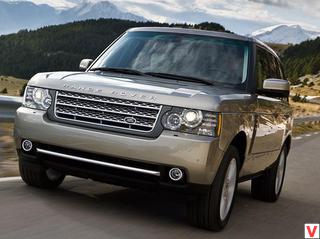
There are also no complaints about the spaciousness for the five sitting people (the rear ones, by the way, can be separated from the front ones by a glass partition) and the lack of space for equipment in the trunk. Standard climate control allows you to create in the cabin three different climatic zones. In addition to air, all seats, a windshield, mirrors and even a leather steering wheel rim are heated in the cabin! "Large-caliber" government bodies are very lucid.
Suspension comfort with automatically adjustable stiffness varies by pavement type and speed and, on average, is well insulated from potholes. Petrol 4.4 liters capacity of 282 hp The modified V8 from the BMW X5 surprisingly easily and vividly throws more than two tons of weight along a winding road from turn to turn. The adaptive 5-speed “automatic” quickly and gently replaces the gear, almost responding with lightning speed to the manipulation of the floor “gas” pedal, light and sporty-precise.
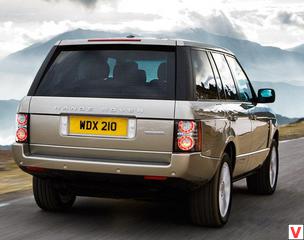
A manual shift mode is hardly inferior to other "mechanics." Range Rover quickly and correctly executes commands from the driver, who is provided with an unexpectedly sharp steering wheel with completely light reactions, accurate and filled with the necessary weight with increasing speed and lateral acceleration. He has sensitive and powerful brakes and he is well opposed to bend tires in the corners. The body rolls make him related to other large SUVs, but his control does not suffer from this. In the spring of 2005, global sales of an upgraded version of the Range Rover began.
The car of 2006 model year is distinguished by the original “mesh” grille, new headlights, front bumper and new wheel design. But the main innovation was the gasoline engine of 4.2 liters with two mechanical superchargers, developing 390 hp Modernized and the base engine of 4.4 liters is now developing 300 hp For both engines, a new 6-step "automatic" Command Shift. In Europe , a version with a 2.7 liter turbodiesel with a capacity of 190 hp is also offered.
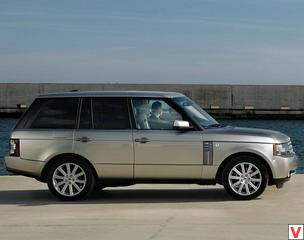
The list of main and additional equipment includes a rear-view camera, a tire pressure sensor, adaptive xenon headlights, an infotainment system with two 6.5-inch screens for rear passengers, a new navigation system and a harman / kardon audio system (11 or 14 speakers) with a single touch screen. Unique in terms of strength and torsional and bending stiffness, a steel body with a sandwich floor received additional noise insulation, which reduced the noise level in the cabin.
The suspension is completely independent, in front - on suspension struts with lower wishbones and tie rods, in the rear - on double upper and lower levers, and instead of the usual shock absorbers, pneumatic elements are used with adjustable ground clearance (range - 270 mm in front and 330 mm in the rear). Gamma modifications for the 2006 model year - HSE, Vouge and Supercharged. Equipment is fully consistent with the class of car - trim leather, wood and polished aluminum, all systems of active and passive safety, separate climate control, full power, sunroof and much more. The most outstanding quality Range Rover exhibits off-road.
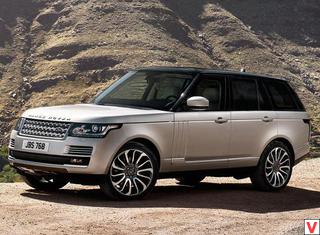
It flies up on dizzying hills, gracefully climbs the rocks, storms the ford of the river, bites into the sand, kneads mud and eventually brings you to the place where you never dreamed to get. The 2010 Range Rover Model Go was presented at the New York Auto Show. Designers managed to refresh the look of the car, while not one iota without changing the overall style. Improvements to the design of the Range Rover include a modified exterior that features narrower headlights with LED sections, an enlarged grille, other direction indicators, a new bumper, decorative gills in the front fenders and new rims. Fog lights with bumper moved to the lower air intake.
Range Rover is still one of the most luxurious all-wheel drive cars in the world. In the exterior of the model, aristocracy and nobility are perfectly manifested. Inside the Range Rover is also transformed. New finishes of top quality leather, which, including the lined ceiling, pillars and doorways, increases the comfort of the cabin to an even higher level. Gorgeous interior style is complemented by high-quality matt black finish and natural wood. The new dashboard features buttons with “matt chrome finish”.
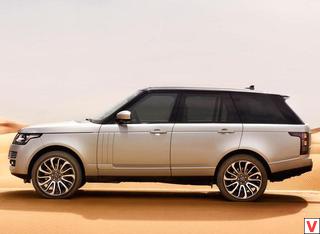
But the main change in the cabin is two LCD screens. One replaced the traditional speedometer and tachometer. It also displays the data of the trip computer and the operating modes of the Terrain Response system. And the second - in the center of the panel - is the “face” of the multimedia system. On it, in particular, you can watch TV / DVD, control music (touch screen) and use the navigation system (also, by the way, updated). This screen, perhaps, is the main "chip" of the new Range Rover. It uses Dual View technology. The driver and the front passenger see completely different images on the same screen.
The driver can safely use the navigation, while the passenger will enjoy watching the movie. But in this case, passengers from the rear seat will see a jumble of two pictures on the screen at once. In the interior of the Range Rover, everything is at a high level: trim, fitment of interior elements, functionality, ergonomics and comfort. The driver will appreciate the high seating position, which provides excellent visibility and comfort. In the Russian market, Range Rover is offered in 4 versions: Vogue, Westminster, Supercharged, Supercharged Westminster.
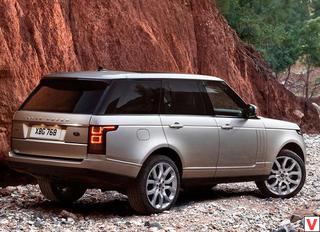
Range Rover 2010 model year has received two more powerful petrol V8 working volume of 5,0 l - in the atmospheric version capacity of 375 hp and in the Supercharged version (with a mechanical compressor) with a capacity of 510 hp, the Engine was developed by experts on Jaguar and Land Rover power units, and from the very beginning the design was carried out specifically for the Range Rover model. The LR-V8 engine is much more powerful and more efficient than the previous ones, but at the same time, fuel consumption and emissions have not increased. Fuel consumption in this car, compared with the previous engine, is reduced by 7.3%, and CO2 emissions - by 7.4%.
The car also retained the previous 3.6 V8 turbodiesel with a 272 hp Common Rail. Since the second half of 2010, this turbodiesel is replaced by a 4.4-liter capacity of 313 hp. In the new car applied advanced technologies that increase the comfort and safety of driving. The car is equipped with an advanced adaptive dynamic system, thanks to which the impeccable driving performance of the Range Rover is even better. The Terrain Response® road adaptation system is complemented by another new Adaptive Dynamics mode, which is designed for optimal control when cornering or braking at high speeds.
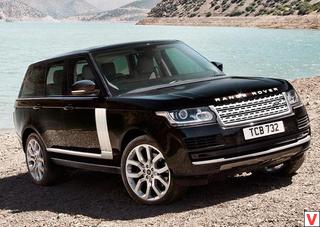
The use of this mode allows you to minimize the impact of road irregularities, regardless of whether the car is driving on asphalt or sand, on snow or dirt. The Range Rover package for the 2010 model year also includes a number of advanced active safety features, including adaptive cruise control, trailer monitoring, braking booster, dead zone control, automatic intelligent lighting and a camera system. Chambers of the new circular view system facilitate parking, towing and maneuvering off-road. The system consists of five digital cameras that transmit an almost circular image to the touch screen.
Cameras turn on immediately after starting the engine and can be used at speeds up to 18 km / h. Image selection and zoom options help when parking in tight places and when towing a trailer. For more comfortable night driving, Range Rover headlights are equipped with intelligent lighting. It allows you to automatically turn on the high beam when the ambient light level falls below a predetermined value. The system also determines the presence of cars moving behind and towards, and in a split second automatically switches the headlights to low beam so as not to blind other drivers. The changes also affected the infotainment system.
The new navigation system with a hard disk is characterized by an accelerated route calculation, an expanded map coverage and increased reliability. The new interface of portable audio devices is used to connect a variety of portable audio devices, USB-drives and MP3-players, providing access to the functions of these devices and control them through the touch screen on the dashboard. One of the ports is designed specifically for connecting an Apple iPod in Land Rover cars. The fourth generation Land Rover Range Rover (factory index model L405) created a splash at the 2012 Paris Motor Show. The model was developed from scratch.
It has preserved the spirit of innovation and the classic design of the original model, which changed the automotive world after its appearance about 40 years ago. This is the first SUV in the world that uses the revolutionary technology of a solid aluminum body frame (which is 39% lighter than the steel body of the previous model), which made it possible to reduce the total weight of the car by 420 kg. And this is with the increased external dimensions. The increase is certainly small, but the 2013 generation is 33 mm longer, 27 mm wider, 20 mm lower. The distance between the axles increased by 176 mm, the increase went to increase the living space of second-row passengers.
As a result, the dimensions of the Range Rover 4 of 2013 (L405) are 4999 mm in length, 1835 mm in height, 1983 mm in width, 2922 mm wheelbase, clearance due to adjustable air suspension (5 levels) can vary from 228 mm to a fantastic 303 mm. The car is large, but the drag coefficient of the air flow is 0.34 Cx. Separately, it should be said about the ability of the 2013 Range Rover to force water barriers to a depth of 90 cm. The predecessor could boast only a little less than 60 cm overcome fords.
Such an enviable result for many off-road manufacturers was achieved by Land Rover engineers using the ingenious placement of an air intake system with inlet channels in the form of labyrinths on the upper ends of the front wings under the hood of a car. With the geometry of the body everything is in order, depending on the chosen level of clearance, the angle of entry is from 26 to 34.7 degrees, and the angle of exit is 24.6-29.6 degrees. From any viewing angle the car looks bright, charismatic and majestic. Exterior designers fully preserved the traditional look of previous generations in the image of the modern Range Rover.
Classic straight lines, a familiar profile, huge wheel arches, a rear bumper clipped to the bottom for better off-road performance. The body contours have become smoother, and the front of the SUV with the new bumper, grille and optics has something in common with the younger model Evoque. Owners will be able to choose the color of linings and moldings, from the classic chrome to contrast to the main body color.
At the end of the conversation about the exterior let's say about the amazingly beautiful wheels and interesting options for body painting. The manufacturer offers alloy wheels in the size of R19 - R22, the most expensive versions flaunt on wheels 275/40 R22. The salon is made in accordance with the highest quality standards of luxury cars. The noise level inside the cabin has been significantly reduced due to the careful optimization of the body frame and soundproofing of the windshield and side windows. The interior is stylish, beautiful, functional and noble. In the interior decoration using only quality materials. Ergonomics cabin calibrated to the smallest detail.
Comfortable fit is provided to all passengers. Legroom in the back row increased by more than 118 mm. When ordering a car, the future owner can choose a double (two separate chairs) or a triple (traditional sofa) back row configuration. In the first case, on the royal places, separated by a powerful central tunnel with a climate-control unit on a horizontal plane and a wide armrest, conveniently accommodate two people.
Places overhead and the width of the cabin with a margin. Triple sofa is less comfortable. Convenience driver above all. A chair with a flat pillow, but expressive support of the rollers located on the back. Power and a huge range of settings allow you to sit comfortably driver of any body size and height.
The steering wheel, the virtual dashboard, the center console with a color monitor, a separate climate control unit and a minimal set of buttons look flawless and stylish. The rich basic equipment of an SUV can be supplemented with a number of options, among which are the 8-inch screen of the multimedia system, 4-zone climate control, front seats with massage function, as well as LED interior lighting. The rear door is two-piece. The door opens with the help of two buttons; when you press the first one located in the recess above the license plate frame, the main door of the compartment will open, the bottom side will lower after pressing the second one (located on the bottom sash).
The reverse process is carried out with one click on the button at the bottom. With a full passenger compartment, the trunk volume is 909 liters, by folding with the help of an electric drive (there are buttons on the trunk side), the back row can be increased to 2030 liters. For Land Rover Range Rover 2013, three power units are offered - a 3.0-liter TDV6 turbodiesel with a capacity of 258 hp.
(600 Nm), already familiar to the 4.4-liter TDV8 turbodiesel, issuing 339 forces and 700 Nm, as well as the gasoline 5.0-liter supercharged “eight” with a return of 510 “horses” (625 Nm). All engines are aggregated together with the non-alternative 8-speed ZF, providing acceleration from zero to a hundred in 7.9 (with diesel V6), 6.9 (with diesel V8) and 5.4 (with petrol V8) seconds. The maximum speed of the SUV reaches 209, 217 and 225 km / h, respectively. At the same time, the average fuel consumption of the Range Rover 4 2013 in the combined cycle is 7.5 liters per hundred kilometers. This is data for a car with a basic diesel engine.
The version in the eight-cylinder diesel engine consumes 8.7 liters under the same conditions, and the appetite of the gasoline engine is already 13.8 liters per hundred. Among the technical innovations is a completely new air suspension capable of lifting the body by 40 and 75 mm (in the latest version, the ground clearance is 303 mm), as well as the new generation Terrain Response system, which independently analyzes the current road conditions and selects the most appropriate settings. The driver can forcibly choose one of the modes of all-wheel drive: grass - gravel - snow, mud - ruts, sand and even rocks (for driving on cobblestones).
